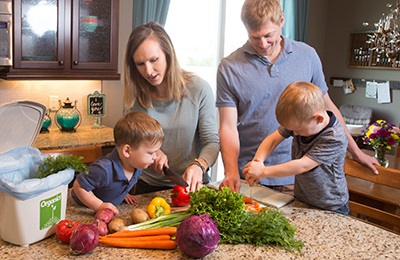Composting at home

Start recycling your food scraps and yard waste into compost. From waste sorts, we know that 20% of our trash is food. This means that preventing food waste and composting food scraps is the biggest opportunity to reduce waste. Additionally, food scraps decomposing in landfills create methane emissions — a potent greenhouse gas.
Backyard composting is something you can do at home to reduce waste and prevent emissions.
Hennepin County offers online webinars and resources to help you get started. Learn more.
Composting basics
Here are the basic steps to composting in your backyard:

Pick out a bin
Many lawn and garden stores sell compost bins that require minimal assembly. Additionally, you can search for options online to make a compost bin yourself with a few materials and tools.
Set up the bin
Place your bin in a convenient location for easy access. An ideal spot gets some sun, has good drainage and is easily accessible.
Start with a layer of coarse yard waste, such as twigs, on the bottom of the pile. This allows for good air circulation.
Add materials
The four basic ingredients for your compost bin mix are:
- Greens: fruit and vegetable scraps, grass clippings, and plant trimmings
- Browns: dry leaves and grasses, straw, and twigs
- Water
- Air
You want to add a proportion of three parts brown materials, which add carbon, to one part green materials, which provide nitrogen.
Maintain your pile

Turn your pile with a pitchfork or spade once a week to provide air to help break down the compost and control odors.
Use your compost
When the compost is ready, scoop it out and put it on your garden to add nutrients to your soil and keep weeds down.
For more detailed instructions on composting in your backyard, see the how to compost in your backyard flyer (PDF).
Frequently asked composting questions
Below are frequently asked questions we’ve received from residents about backyard composting in Minnesota.
Should the compost bin be in the sun? Or is the shade okay?
It doesn’t really matter if you put your bin in the sun or the shade. It's most important to put your bin in a spot that's convenient for you. Most of the heat comes from the organisms within the pile. If you have a black plastic bin, it may get a little warmer in the sun.

How often should you turn your compost?
Compost will break down more quickly if you turn it, but the materials will still break down eventually if you don’t turn them. You should aim to stir the compost at least once in the spring and once in the fall. To get finished compost sooner, turn your pile weekly or monthly. Mixing the compost will also help to add air to the pile.
Why is my pile not breaking down?
It’s probably too dry. There are a few options to get the compost to break down:
- Stir the pile
- Water the pile
- Add more food scraps

When will the compost be ready?
In Minnesota, you can expect to have finished compost in about six months to one year.
Can you compost in the winter?
Yes, you can continue to add materials over the winter. A backyard compost pile in Minnesota will freeze over the winter, but it will thaw and start breaking down again in the spring. Remember to shovel a path to your compost bin so it’s still accessible when there’s snow.


